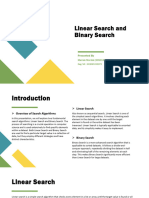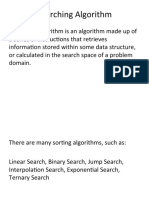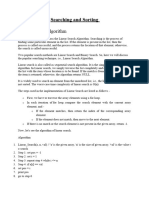0% found this document useful (0 votes)
34 views4 pagesName : Usman Ahmad Siddiqui
Usman Ahmad Siddiqui submitted a topic on linear and binary search, and sentinel values for his 3rd semester session 2018-2022.
The document describes linear search as sequentially checking each element of a list to find a match or search the entire list. It has simplicity but poor performance scaling linearly with input size. Binary search compares the target to the middle element, recursively searching the left or right half depending on whether the target is smaller or larger than the middle element. It has logarithmic time complexity and is faster than linear search for large inputs but requires a sorted list. A sentinel value is a special value used as a condition to terminate a loop or recursion, like continuing a loop until a variable equals -1
Uploaded by
Usman SiddiquiCopyright
© © All Rights Reserved
We take content rights seriously. If you suspect this is your content, claim it here.
Available Formats
Download as DOCX, PDF, TXT or read online on Scribd
0% found this document useful (0 votes)
34 views4 pagesName : Usman Ahmad Siddiqui
Usman Ahmad Siddiqui submitted a topic on linear and binary search, and sentinel values for his 3rd semester session 2018-2022.
The document describes linear search as sequentially checking each element of a list to find a match or search the entire list. It has simplicity but poor performance scaling linearly with input size. Binary search compares the target to the middle element, recursively searching the left or right half depending on whether the target is smaller or larger than the middle element. It has logarithmic time complexity and is faster than linear search for large inputs but requires a sorted list. A sentinel value is a special value used as a condition to terminate a loop or recursion, like continuing a loop until a variable equals -1
Uploaded by
Usman SiddiquiCopyright
© © All Rights Reserved
We take content rights seriously. If you suspect this is your content, claim it here.
Available Formats
Download as DOCX, PDF, TXT or read online on Scribd
/ 4





































































